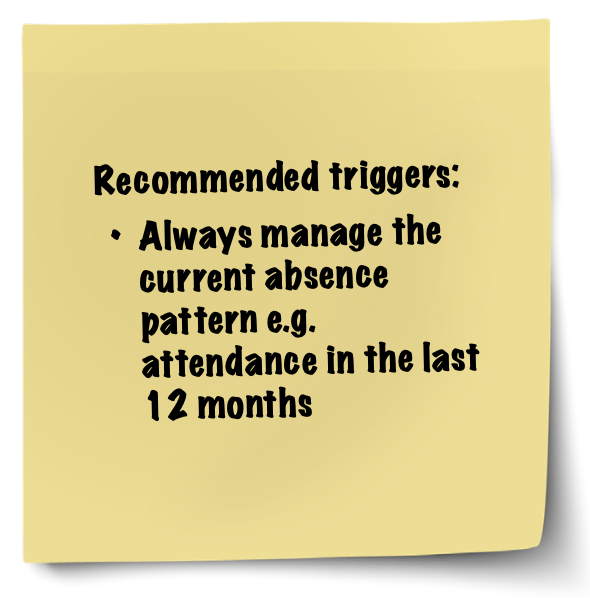How to address recurring absence in your policy
A good absence policy sets out acceptable levels of absence and guides managers to review absence patterns early on. It should also provide a clear guide for follow-up actions. When more serious consequences should follow from a poor attendance record. Quite often the first meeting or referral is not the end of the story. The condition may cause another absence further down the line. There may also be follow-up actions like workplace adjustments and risk assessments to complete as a result of the initial review. Managers should review regularly if the measures are working and check in with how the employee is doing, especially if they have a further absence from work.
Don’t: Fall into the trap of accumulative tiers
Deciding when the first review meeting should take place is usually pretty straightforward, even if the trigger points follow one of the more complex rules discussed in the earlier chapters. Further complications arise when it is time to decide when a 2nd meeting should take place. A logical approach seems to be to create tiers. Most companies have a 3-tiered disciplinary system so why not have 3 tiers in the triggers, too?
After the first review meeting, the employee might be placed on tier 1 for a period of time, for example. If they have no further absence in this period, they get dropped back to baseline. Tier 1 usually has more stringent trigger points and hitting these triggers would push the employee up to tier 2 and towards the 3rd stage, or dismissal.
Here’s an example:
1st absence review: 3 spells in 12 months
2nd absence review: 1 spell in 3 months or 2 spells in the 12 months following first review
3rd absence review: 1 spell in 3 months or 2 spells in the 12 months following second review
The problem with this approach is that now it becomes necessary to keep track of how many spells of absence each employee has had, not only in the last 12 months, but since the last review meeting! This is probably the most difficult of all the trigger systems to keep track. This is because the start date of the reference period could be different for each employee.
Do: Manage absence based on a rolling 12-month history
Sticking to your normal company trigger points on an ongoing basis is a much easier approach than using tiers. The same triggers apply to all employees and the system is easy for everyone to follow. To take into account recent improvements or deterioration in attendance, the triggers should always refer to a rolling 12-month period.
If the trigger is 3 spells in 12 months, and one review meeting has already taken place, then the next review meeting should be arranged if the employee has another absence that meets the 3 in 12 trigger point. Simple! If you’ve had several meetings with the same employee in a short space of time, you may choose to set a 3-month improvement period and schedule a follow-up meeting in 3 months’ time.
This chapter is part of our “Make It Simple” Absence Policy series. If you’d like to learn more about writing a best practice absence policy, sign up to our newsletter for your free copy of the full eBook.

